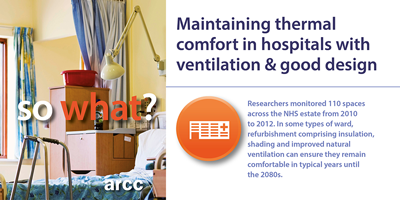Researchers at the University of Cambridge identified ventilation strategies and design characteristics for refurbished and new build hospitals, to prevent overheating while maintaining thermal comfort and reducing energy use.
The DeDeRHECC project (University of Cambridge) investigated how the NHS Estate can increase its resilience to summertime overheating whilst simultaneously meeting the carbon reduction targets set by the Climate Change Act.
Design options for new hospitals focused on environmental strategies to cope with a simulated future climate, from use of simple natural ventilation through to full air-conditioning and filtration. The potential for refurbishment and ventilation strategies for existing hospital types was also investigated. Research found that, in many cases, existing hospital buildings can significantly improve their resilience while maintaining thermal comfort of staff and patients, and reducing future energy use.
Relevance
The UK Climate Projections suggest that annual mean temperature will increase by 2.5–4.2˚C by the 2080s, whilst the Climate Change Adaptation Sub-Committee states that 90% of the UK hospital stock is vulnerable to overheating. According to the Heatwave Plan for England: Making the Case, there is strong evidence on the risks of excessive heat on health, especially for vulnerable groups such as the elderly, infants and those with chronic or severe illnesses.
The UK has set a legally binding target to reduce its carbon emissions by 80% by 2050, which includes public sector buildings such as the NHS estate. Achieving this aim requires adoption of low energy design strategies for both new buildings and, more importantly, existing buildings.
Barriers to innovative interventions include limited understanding of the risk to patient safety and wellbeing, and poor understanding of how occupants’ behaviour, particularly in vulnerable patients, changes to accommodate increases in indoor temperature.
Findings
The researchers monitored 110 spaces across the NHS estate from June 2010 to September 2012. NHS building types include: matchbox on a muffin; best buy/closed court; nucleus/open court; Nightingale pavilions; linear slab; and deep plan.
- Refurbishment could improve internal conditions in the current climate and reduce energy use – considerably cheaper and quicker than demolition and replacement.
- Refurbishment options also increase the resilience of buildings, including Nightingale and matchbox on a muffin types. Insulation, shading and improved natural ventilation can ensure that in typical years wards such as the Nightingale-type remain comfortable until the 2080s.
Now what?
Modest refurbishment can reduce overheating risk in existing hospitals; improved design and ventilation strategies can provide thermal comfort during hot summers from now until the 2030s or, for some building types, up to the 2080s.
Low Carbon refurbishment options and natural ventilation design strategies should be considered over energy-hungry, fully mechanically-ventilated options for hospital buildings.
Refurbishment and ventilation strategies should take into account occupants’ thermal comfort and the use of the adaptive comfort standard BS EN 15251: 2007 when assessing patients’ summer thermal comfort.
Designers
Explore the potential of design strategies which eliminate or reduce the need for mechanical cooling, not only under current climatic conditions, but also under future summer scenarios.
NHS Estate energy managers and Trust Board members
Investigate refurbishment options in terms of energy reduction, cost efficiency, and thermal comfort, especially with regards to summer overheating.
Policy-makers
Reconsider building standards with regards to thermal comfort and ventilation, focusing on healthcare environments and vulnerable patients.
Researchers
- Investigate implementation of adaptive comfort standard BS EN 15251: 2007 for hospital occupants, particularly vulnerable patients. Explore an acceptable temperature range in healthcare environments.
- Research patient risk in terms of airborne infection, and temperature minima and maxima.


